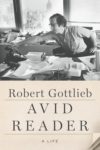Publishing Insider
 Avid Reader: A Life, Robert Gottlieb (Macmillan/FSG; RH Audio; OverDrive Sample) is getting attention in the book press. No surprise. What book review editor wouldn’t be interested in him?
Avid Reader: A Life, Robert Gottlieb (Macmillan/FSG; RH Audio; OverDrive Sample) is getting attention in the book press. No surprise. What book review editor wouldn’t be interested in him?
He published, perhaps most famously, Joseph Heller’s Catch-22, but the list of who he has worked with is as long as it is impressive, including Nora Ephron, Diana Vreeland, Antonia Fraser, Robert K. Massie, Mikhail Baryshnikov, John Cheever, Salman Rushdie, John Gardner, Len Deighton, Ray Bradbury, John Lennon, Paul Simon, and Bob Dylan (see the Paris Review‘s lengthy overview).
It’s just the thing for anyone interested in an insider’s account of the publishing world. “Not since Max Perkins worked with Hemingway and Fitzgerald has there been a more admired editor than Robert Gottlieb,” writes Michael Dirda in his Washington Post review quoting Gottlieb as defining the publisher’s role as “essentially the act of making public one’s own enthusiasm.”
The New York Times review points out those enthusiasms were varied, “he seemed to have a hand in everything that mattered” as he worked at Simon & Schuster, Alfred A. Knopf and The New Yorker.
The story goes on to call his memoir one of “grace and guile and a sometimes-barbed wit … an indispensable work of American publishing history, thick with instruction and soul and gossip of the higher sort,” even if it does have, as they say, “a self-congratulatory ring” about it.
The New Republic examines, in part, Gottlieb’s “lack of snobbery about popular fiction,” writing that after years of working with “Michael Crichton, John Le Carré, and other category masters [Gottlieb knew] that bestselling fiction writers are, in essence, their own genre”:
“Detective novels are a genre, but so is Agatha Christie. Spy novels are a genre, but so is John Le Carré. And something I’ve always found heartening is that the reading public usually gets it right. Yes, there are inferior genre writers who become highly popular, but on the whole the most popular ones are the ones who are the best at what they do.”
He tested this theory on romance novels, reading Nora Roberts, Jude Deveraux, and Sandra Brown, and decided that Roberts, “by far the biggest seller of them all, was by far the best writer of them all.” Gottlieb puts his faith in readers, saying, “the public knows and responds accordingly with continued sales.”
That is why, the article continues:
“sixty years into a publishing life, Gottlieb is equipped to chronicle how the book business became more commercial and consolidated, even as the focus remained on the author. Much as we want to think of book publishing as a lofty ideal, it is hardly that, as any field with profit margins and budgets must be. But Gottlieb, as both editor and publisher, recognized you could make money, even a little, off books about dance, while making obvious blockbusters by Bill Clinton or Nora Ephron or Michael Crichton all the smarter.”
